|
Nicole Maxwell One of the many joys of summer break from school for students is the pleasure of having the opportunity to read books that they choose. For some this might mean enjoying books written by favorite authors while others explore books by authors new to them. The theme of 2024 Children’s Book Week is “No Rules. Just Read.” Encourage young people to take advantage of summer break to continue the celebration of the 2024 Children’s Book Week. Below are reviews of just a few recently published books that are representative of the array of options for enjoyable summer reading.  Beach Bummer (Little Bruce #4). Ryan T. Higgins. (2024). Disney Hyperion. Bruce the bear is his usual grumpy self on this hot, hot summer day in Soggy Hollow. Although Bruce would rather do nothing, as the book he is reading, The Joys of Doing Nothing, demonstrates, his family of mice and geese want to have a day at the beach and excitedly run out ahead, leaving Bruce begrudgingly toting all the beachy gear. Everyone, except for Bruce, is enjoying their sunny beach adventure until the rain comes, but has the rain spoiled all their fun? While the text is spare, Ryan T. Higgins’s amusing signature illustrations of Bruce with his unmistakable unibrow and sullen face, along with the animated features of his family members, make this a fun-to-read tale for the summer. Young readers will love Spring Stinks (2021), Thankful for Nothing! (2021), and Out Cold (2023), the earlier seasonal Little Bruce books too. (PreK Up)  Bros. Carole Boston Weatherford. Illus. by Reggie Brown. (2024). Candlewick. Inspired by the #BlackBoyJoy meme, Carole Boston Weatherford presents the sunrise-to-sunset activities of five Black friends and one boy’s pet dog as they visit their community’s playground, park, garden, library, and basketball court. Throughout the day, they play, use their imagination to make a time machine, engage in a royal pretend battle, read books, and play basketball. Weatherford’s spare, rhythmic text and Reggie Brown’s vibrant and lively illustrations convey childhood experiences with friends that involve happiness, laughter, and the making of lasting memories. This book communicates the significance of friendship and the reality that Black boys, just like all children, deserve to experience a carefree childhood full of enjoyment. (PreK-Gr 2)  Ferris. Kate DiCamillo. (2024). Candlewick. Emma Phineas Wilkey, nicknamed Ferris (as she was born beneath a Ferris wheel), learns the meaning of her Grandmother Charisse’s saying, “Every good story is a love story,” as she deals with events in her decidedly unconventional family during the summer before fifth grade. Charisse shares that she sees a ghost at the threshold to her room with Ferris and enlists her to help the ghost find peace and be reunited with her loved one. Ferris’s little sister, Pinky, has vowed to live the life of an outlaw and engages in shenanigans that test the nerves of the family. Uncle Ted, recently separated from Aunt Shirley, moves into the Wilkey’s basement to paint a history of the world and asks Ferris to spy on her aunt. Thankfully, Ferris has her best friend, Billy Jackson, by her side to help her navigate all that is happening in her life. Love and humor, as well as some vocabulary words learned from Ferris’s and Billy’s fourth grade teacher, abound in Kate DiCamillo’s latest novel that middle grade readers are sure to love. (Gr 3 Up)  Good Night, Good Beach. Joy Cowley. Illus. by Hilary Jean Tapper. (2024). Gecko. Joy Cowley tells a bedtime story summing up the end of the day for a family on summer vacation at the beach. The family leaves the beach with “sunburned skin and sandy feet.” One child arranges her newfound treasures of white shells and sea glass under her pillow while the other children watch her and then get ready for bed. Together they bid the beach goodnight as they gaze longingly at it from the window. Hilary Jean Tapper’s soft hued watercolors-and-ink illustrations beautifully complement Joy Cowley’s sparse, rhythmic text. This story is sure to create warm memories of past summer vacations and leave young readers longing to spend time at the beach this summer. (PreK–Gr 2)  Mahogany: A Little Red Riding Hood Tale. JaNay Brown-Wood. Illus. by John Joven. (2024). Charlesbridge. This modern version of “Little Red Riding Hood” introduces Mahogany as a savvy young Black girl and gifted seamstress sewing a red patchwork cape while listening to music through headphones. Once Momma gets Mahogany’s attention, she asks her to deliver some freshly made honey cornbread to G-Ma’s house and warns her to stay alert. Mahogany heads to G-Ma’s through the woods, of course, and encounters the hungry wolf. Knowing a strange wolf in the woods is not to be trusted, she offers him the cornbread and tosses her cape over his head and entangles his limbs as he devours it. Then she runs away, fools the scheming wolf by blending in with her surroundings, and devises a clever plan to use her skills to protect G-Ma and herself. John Joven’s colorful, textured, cartoonlike illustrations created digitally portray Mahogany as a girl with “melanin deep in her dark skin,” as Brown-Wood describes her. (PreK–Gr 2)  No Cats in the Library. Lauren Emmons. (2024). Paula Wiseman. “Clarisse was a stray cat who loved books.” When she sees a building that people come out of with books in hand, she must find a way to get in there. Unfortunately, the “keeper of the books” makes her leave saying, “No cats in the library.” Then Clarisse finds the book drop and manages to sneak in unnoticed by dropping down the chute. When she finds a young girl just learning to read who offers to read the story to Clarisse, her love for books grows exponentially as she realizes that the squiggly lines in books tell stories that accompany the pictures she has been seeing. Will she be able to stay this time, or will the keeper of books find her and kick her out, again? The “Read to Our Cats” sign in Laura Emmons’s colorful digital illustrations reveals a happy ending for Clarisse as a reading companion in the library. (PreK-Gr 2)  The Last Bookwanderer (Pages & Co. #6). Anna James. Illus. by Marco Guadalupi. (2024). Philomel. In the final installment of the Pages & Co. series, Milo, Tilly, Oscar, and Alessia are on a mission to save the world’s imagination from the Alchemist and protect the magic of bookwandering. To do this they travel into Arthurian legends searching for the first bookwanderer, Merlin the Wizard, to seek his help. Merlin sends them into Greek and Norse mythology where they learn about the mysterious roots of bookwandering and begin questioning all that they have known about it. Anna James skillfully wraps up this fantastic adventure series by connecting this last book to previous ones. Readers will be enthralled from the beginning of The Last Bookwanderer and will have a hard time putting it down until all the secrets are revealed. It will be hard for fans to say goodbye to this imaginative series of books. (Gr 3 Up)  Running in Flip Flops from the End of the World. Justin A. Reynolds. (2024). Scholastic. In this entertaining follow-up to It’s the End of the World and I’m in My Bathing Suit (2022), 12-year-old Eddie Gordon Holloway, “your friendly narrator and master storyteller,” starts by apologizing directly to readers for the cliffhanger that ended the first book. Eddie and his four friends are still trying to survive the potential apocalypse. One thing is certain, they have no idea where everyone else is or what happened. If only they could make it to the beach where the town’s biggest event of the summer was happening when this all started. The friends decide to create their own video diary, allowing readers a glimpse into the other characters’ thoughts in addition to what Eddie freely shares throughout the book. Justin A. Reynolds hooks readers from the beginning and keeps them wondering what will happen next until the very end, which sets the stage for the series to continue. (Gr 3-5)  The Secret Language of Birds. Lynne Kelly. (2024). Delacorte. Nina is accustomed to feeling like the odd one out at school as well as at home where she is the middle child of five. She is an amateur birdwatcher with a deep desire to learn more about birds, and she is also a bit socially awkward. As summer arrives, she takes advantage of the opportunity to visit her Aunt Audrey’s summer camp in Bee Holler, Texas, which is appealing for potential birdwatching and space away from her busy family. While on a clandestine journey to an off-limits area of camp with her new friends from the Oddballs cabin, as well as other campers, she discovers what she thinks may be a whooping crane and its nest. However, that can’t be possible since no whooping cranes have nested in Texas for over a century. Thus begins her adventure of confirming the bird’s species and secretly monitoring the nest with her friends until the secret gets out. This is a touching account of growing up and finding your niche. (Gr 3 Up)  Summer is Here by Renée Watson. Illus. by Bea Jackson (2024). Bloomsbury. “Summer is here! // She tiptoes into my room, / waking me up with her light. / Her sunrays tickle me, whispering, // Rise and shine.” Renée Watson personifies summer in this ode to summer’s arrival through a young African American girl’s experiences on her perfect summer day from sunrise to sunset. The girl starts by wondering, “What joy will summer bring me today?” She finds that it brings fresh fruits, swimming and jumping rope with friends, a cookout with family and friends, ice cream treats, and the sun’s warmth on her skin. At the end of the day, the girl longingly stares at the moon and stars and shares her desire, “I wish summer would stay.” Bea Jackson’s digital illustrations bring the flawless day to life through luminous light and realistic depictions of diverse children and adults that complement the celebratory mood of Watson’s text about summer and its many joys. (PreK-Gr 2) Nicole Maxwell is an associate professor specializing in literacy instruction in the Elementary and Special Education Program at the University of North Georgia.
0 Comments
Nancy Brashear and Carolyn Angus Readers of all ages will be captivated by the creative storylines and formats of the recently published fantasy and science fiction books reviewed in this column. From a picture book for the youngest readers to chapter books for middle grade readers to a complex stand-alone book and first books in a series for older readers, each book offers readers the opportunity to exercise their imaginations as they meet traditional fantasy characters as well as a diverse group of humans having fantastical adventures set in make-believe worlds, futuristic Earth, or outer space.  Charlie Hernández & the Phantom of Time (Charlie Hernández #4). Ryan Calejo. (2024). Aladdin. In this latest fantastic adventure of Charlie Hernández, South Florida middle schooler Charlie, a morphling who can manifest physical characteristics of animals, receives a letter from his dead grandmother predicting “The future is doomed . . . Death reigns” in less than five hours if he cannot stop the obliterating attack to be launched by La Mano Peluda on the Land of the Living in Florida in their 5,000-year war. He must solve the mystery of “The Five Donkeys” in 1956 Cuba. Charlie and his young teen compatriots (cousin Raúl, girlfriend and investigative journalist Violet Rey, and paranormal skeleton Esperanza) embark on a time-travel quest that takes them to Cuba, Colombia, and other locations that come alive in magical and, often, horrifying ways. Teaming up with another time traveler, Evelyn, they uncover more clues, face more enemies, and battle against increasingly unbelievable odds to save the world. With snarky banter augmented by Spanish and Portuguese words and phrases sprinkled throughout and non-stop action, readers new to the series will be hooked and want to seek out the earlier books: League of Shadows (2018), The Castle of Bones (2019), and The Golden Dooms (2022). (Gr 6 Up) —NB  Daughters of the Lamp (Daughters of the Lamp #1). Nedda Lewis. (2024). Putnam. Twelve-year-old Egyptian American Sahara Rashad never imagined flying to Cairo for her Uncle Omar’s wedding and a two-week visit with the family of her mother, who died when Sahara was born, would immerse her in a family mystery involving magic. In a second narrative set in 985 CE, Morgana, the 13-year-old servant of Ali Baba, flees Baghdad with a jinni lamp and other magical treasures to fulfill the promise she makes to her dying master, who had been attacked by an evil sorcerer, to protect them. As the wedding of Omar and Magada, who Cousin Namia is convinced is a witch, approaches, the necklace Sahara inherited from her mother starts glowing and then disappears. Following a break-in at the family’s shop, Sahara learns that Ali Baba’s treasures have been hidden in an underground chamber and realizes that she must accept her legacy as guardian of the lamp. The second book in this fast-paced fantasy, Children of the Wind, will be published this June. (Gr 3 Up) —CA  The Day I Fell into a Fairy Tale. Ben Miller. Illus. by Daniela Jaglenka Terrazzini. (2024). Aladdin. It is summer vacation, and nine-year old Lana is bored. With the promise of a treat, she agrees to join her mother on a trip to Grimm’s, a supermarket that popped up overnight in their small town. Lana decides on a huge volume of fairy tales although the small elderly man who appears to be the only employee says the stories will be too scary for her. Once her mother starts reading “Sleeping Beauty” to her and gets to the part where the evil 13th fairy casts a curse on the newborn princess, she seems to agree that the tale is too scary when she hides the book. On a return trip to Grimm’s, Lana learns about portals to the fairy tale world in pick’n’mix tubs of candy and, with a push from the clerk, falls down a chute and into the Grimm Brother’s darker version of the tale. Ben Miller’s exciting adventure into the fantasy world may have middle grade readers checking out a collection of Grimm’s fairy tales as part of their summer reading. (Gr 3 Up) —CA  Dead Things Are Closer Than They Appear. Robin Wasley. (2024). Simon & Schuster. Sixteen-year-old Isidora “Sid” Spencer is keeping a low profile as an adopted Korean. She has lost her best friend, Nell, to her almost-boyfriend Finn, and everyone knows about it. Llewelyn (Wellsie), a town with mostly white families, sits on a sealed fault line that keeps old magic locked away and attracts tourism. Unbeknownst to Sid and most people, one of the eight guardians sworn to protect the seal is killed, and this leads to a cataclysmic earthquake ripping the seal open, throwing part of the town into the rift, and releasing zombie-like creatures who feed on the humans. A wall springs up trapping everyone already in the town, and keeping those on the outside, including Sid’s parents, sister, and niece, from returning. When Sid cannot locate her older brother, Matty, she and her cat survive by joining an unlikely group of teens including a guardian. Searching for the other guardians, they dodge magic-hungry strangers in town who are acting like paramilitary and devise a plan using their superpowers (as Sid discovers her own) to close the gap—but will they seal the fault in time to save themselves and the town? (Gr 9-12) —NB  The Last Bloodcarver (The Last Bloodcarver #1). Vanessa Le. (2024). Roaring Brook. Eighteen-year-old Nhika Suonyasan believes she is the last of the heartsooths, Yarongese island people with the magical ability to diagnose and heal a body by the laying on of hands. In the industrialized city of Theumas, where as a practitioner of the ancient art of heartsoothing she would be seen not as healer but a bloodcarver, a monster who kills for pleasure, Nhika is abducted and auctioned off on the black market. The highest bidder is Mimi, the daughter of a prominent industrialist, who wants Nhika to heal a comatose witness to her father’s suspicious death. Nhika’s success in doing so becomes complicated as a murder investigation gets underway, the attending physician makes demands to keep her healing gift a secret, and her uncertainty increases as to whether Ven Kohin, the physician’s assistant, is an ally or a foe. Vanessa Le’s richly detailed first book in this intriguing duology has a heart-stopping ending that leaves the reader eagerly anticipating the publication of His Mortal Demise in March 2025. (Gr 6 Up) —CA  The Selkie’s Daughter. Linda Crotta Brennan. (2024), Holiday House. Brigit, daughter of a selkie mother (Marella) and a human father (Andrew), hides her painfully-trimmed webbed fingers from her classmates. As fishermen in her isolated Nova Scotia village return home empty-handed, many blame the dearth of fish and various misfortunes on a selkie bane—and point at her family. Hardships intensify when diphtheria takes the lives of Brigit’s little brother and others and her mother slips into her seal skin to search for Andrew, who is lost at sea following a storm that destroys much of the town. After her selkie cousins send her visions revealing baby seals being murdered for their skins, Brigit fears the bane is in retribution from the Great Selkie, the golden seal she glimpses in the harbor. Throughout her struggle to accept her land-and-sea heritage, Brigit knows she is the only one who can get to the undersea kingdom of Sule Skerrie to present the selkie king with a plan to stop the pup killings, rescue her father (with the help of friends), and lift the bane so village life can get back to normal. Celtic mythology and songs are woven throughout this engaging coming-of-age fantasy. (Gr 3 Up)  Sky’s End (Above the Black #1). Marc J. Gregson. (2024). Peachtree Teen. When he was ten years old, Conrad’s father, the Archduke of Holmstead Island of the Skylands, was murdered by his brother, who as the new archduke exiled Conrad and his mother from “High” to “Low” to live in destitution while keeping his younger sister, Ella, hidden away. Although Conrad was raised by a compassionate mother, he is strongly influenced by his father’s belief in the governing system of Meritocracy (“The weak fall; the strong rise. Think hate.”), so he trusts no one. Now 16, he qualifies to enter the Selection of the Twelve Trades after his mother’s death, is assigned to the Hunter Trade (his profession for life with a high mortality rate), and fights the gorgantauns, sky serpents with steel scales that are destroying the Skylands. If he wins the deadly Gauntlet contest, Conrad will earn his own skyship, which he plans to use as a getaway vehicle after kidnapping Ella from his uncle. As captain of The Gladian, with his nemesis, Pound, and other shipmates, each harboring secrets, he struggles to find his own identity during brutal battles against gorgantauns and learns who the real enemy is. Readers will be primed for Among Serpents, the next book in this battle-filled adventure trilogy, to be released in January 2025. (Gr 9-12) —NB  The Spaceman. Randy Cecil. (2024). Candlewick. A tiny spaceman comments, “I must confess, at first glance I thought this a rather ordinary planet” as he steps out of his tiny spaceship expecting to have another ordinary day at his job of collection soil samples, labeling the soil samples, and filing the soil samples before moving on to the next planet. But then a creature with wings comes along and flies away with his ship. He gives chase into the unknown and has to flee into the starry dark from “a hideous beast” covered in fur. As the darkness fades, he encounters an extraordinary variety of creatures—some strange, some adorable, some beautiful—and when the creature he had considered to be hideous rescues him from a lily pond and seems to have potential as a friend, the spaceman has a big decision to make upon discovering his ship high up on a branch of a tree. Young readers will enjoy knowing more than the little alien does about “the extraordinary place” he has landed on, such as the furry beast being a dog, from what is revealed in Randy Cecil’s warmly humorous oil paintings. (PreS Up) —CA  The Wishkeeper’s Apprentice. Rachel Chivers Khoo. Illus. by Rachel Sanson. (2024). Candlewick. After ten-year-old Felix tosses his last coin into Whittlestone’s penny fountain and makes a wish that his 16-year-old sister, Rebecca, would like him again, he sees a small elderly man retrieving pennies from the fountain with a fishing pole. Surprised that he can be seen, the man introduces himself as Rupus Beewinkle, the Whittlestone wishkeeper, and offers Felix a job as his apprentice. Rupus needs help not only organizing his chaotic office filled with incoming wishes and fixing wish snags but also in dealing with a wishsnatcher, “a creature of pure despair” that was thought to be extinct, who is responsible for the ever-increasing obliteration of wishes being kept by Rupus. It will be up to Felix to rescue Rupus from the wishsnatcher’s lair before the monster has stripped the last wish from the wishkeeper. Rachel Sanson’s grayscale illustrations for this engaging transitional chapter book complement Rachel Chivers Khoo’s lively magical adventure story. A recipe for Snorlicks, a wishkeeper’s beverage of choice, is appended. (Gr 3-5) —CA Nancy Brashear is Professor Emeritus of English at Azusa Pacific University, in Azusa, California. Carolyn Angus is former Director of the George G. Stone Center for Children’s Books, Claremont Graduate University, in Claremont, California.
Books in series are popular with readers of all ages. This column includes reviews of recently published books for young readers: first books in new series, some much anticipated sequels, and the latest books in episodic series that can be read in any order. These books will leave emergent and newly independent readers eagerly awaiting the release of the next book and reading—and rereading—earlier books in the series as well as seeking similar series. 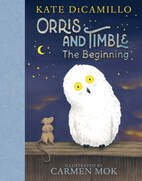 The Beginning (Orris and Timble #1). Kate DiCamillo. Illus. by Carmen Mok. (2024). Candlewick. Orris the rat lives in solitude in a nest behind a hole in the wall of an abandoned barn with his treasures: a red velvet slipper, a marble, and an Imperial Sardine can with a portrait of a king and the words “Make the good and noble choice!!” One evening Orris hears a cry for help and cautiously approaches a young snow owl, Timble, who flew in through a window and got his foot caught in a mousetrap. While talking about “The Mouse and the Lion” fable and heeding the advice of the king pictured on his sardine can, Orris pries open the trap. Timble takes flight only to appear at the hole in the wall wanting to hear the end of the fable. This is not the end of the story of Orris and Timble, however, but rather the beginning. (PreK Up) 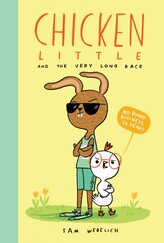 Chicken Little and the Very Long Race (The Real Chicken Little #3). Sam Wedelich. (2024). Scholastic. On the title page of Sam Wedelich’s new picture book tale in cartoon format in the Real Chicken Little series, the cute, white-feathered chick wearing oversize, red glasses and snazzy red cowgirl boots expresses her reluctance to participate in a very long race. Seeing the bad influence Hare, the local record holder and self-promoter of Hop to It: Hare’s Guide to Running, is having on the flock’s training program, however, she decides to train for the upcoming marathon. On the day of the event, Chicken Little’s “SLOW AND STEADY” approach to the challenge of running a very long race has Hare, who stops to sign autographs for his fans, coming in second. On the final page, Chicken Little is pictured pondering what other challenges she could try. (PreK-Gr 2)  Dog Gets a Pet (The Dog and Pony Show #1). Jeff Mack. (2024). Simon Spotlight. Dog gets a pet as a surprise gift from Pony. Upon opening the box with holes in the sides after making some wild guesses about which animal he is getting, Dog is disappointed to see a rock and not the T. rex he really wanted. When Pony suggests that he will like his new pet rock more after giving it a name, Dog calls her Lulu—"Lulu the T. rex who likes to eat ponies.” After a day spent doing other things that Lulu likes to do, Pony says it is Lulu’s nap time. Once Pony reassures Dog that Lulu won’t eat him either, he says, “Pony, I love my new pet. Even if she is just a rock” and settles down for a nap with Lulu. We Are Up a Tree!, the second adventure of Dog and Pony in Jeff Mack’s new Level 1 Ready-to-Read Graphics book series, will be published in September. (PreK-Gr 2) 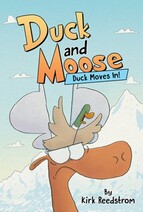 Duck Moves In! (Duck and Moose #1). Kirk Reedstrom. (2024). Disney Hyperion. It is springtime when Duck, a new arrival to the forest, spies the perfect site for his new home—the space between the antlers on Moose’s head. “This will be my forever home. Hiya! I’m Duck.” Exuberant, loquacious Duck’s nonstop chatter has Moose, who does not want to exchange his peace and quiet for “PEACE and QUACK” (the saying on Duck’s sampler), tries to relocate him with no success. When Duck throws a noisy housewarming party atop his head, Moose has had enough. “I said NO! You can’t live there, Duck! . . . because it’s my HEAD!!!” Duck departs and Moose is once again alone—or is he? Chapter 3, “Return of the Duck,” reveals a satisfying ending to this first book in Kirk Reedstrom’s humorous early graphic novel series. Moose Blasts Off! was published simultaneously; Duck in the Dark! will be released in December. (PreK-Gr 2) 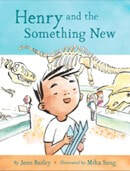 Henry and the Something New (Henry #2). Jenn Bailey. Illus. by Mika Song. (2024). Chronicle. Henry, a young neurodivergent child, is excited about Class Ten’s field trip to a museum but he is also a bit worried about getting there because he has never ridden on a bus. Henry listens as his teacher goes over the rules for the visit, but gets distracted when a huge, noisy bus drives up to the school door and doesn’t hear the third rule. At the museum, Henry responds to “What should we see next?” with a loud “DINOSAURS!” and his group does a special activity in the Bone Room and has a tour of Dinosaur Hall with a scientist. Mika Song’s expressive illustrations rendered in watercolor and ink complement this warm and gently humorous early chapter book in which, at the end of the day, Henry realizes that he actually followed Rule Number Three: Find something new. (PreK-Gr 2) 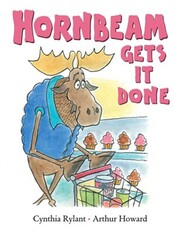 Hornbeam Gets It Done (The Hornbeam Books #2). Cynthia Rylant. Illus. by Arthur Howard. (2024). Beach Lane. Cynthia Rylant and Arthur Howard offer young readers more humorous short stories in this second picture book in their new early reader series about a moose named Hornbeam and his friends. In “March Worries,” Eureka, his neighbor gander, comes up with a sensible solution to Hornbeam’s problem of protecting a little blueberry bush (as well as a lot of other things) in his yard from blowing away during the windy month of March. In “Food-Shopping,” a red-faced shopper helps Hornbeam and Cuddy, a bull, solve their problem of not getting past the yummy cupcakes at the baked goods counter right inside the front door to do their weekly Monday food-shopping: enjoy eating cupcakes and reading the newspaper on Monday mornings and put hot peppers in their mouths so they won’t want cupcakes and do the shopping on Tuesdays. In “Game Night,” Eureka hosts a monthly gathering of all the friends to play board games. “And no matter who won, everybody went home happy!” (PreK Up) 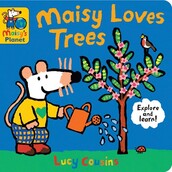 Maisy Loves Trees (Maisy’s Planet #1). Lucy Cousins. (2024). Candlewick. Preschoolers can explore and learn about trees with Maisy, Lucy Cousins’ beloved mouse character, in this first book in the new board book series Maisy’s Planet with Cousins’ signature style artwork featuring Maisy and her friends done in bright colors and outlined with thick black lines and a simple text. Basic information that answer questions such as “What is a tree?” and “Where do trees grow?” is paired with scenes clearly showing that Maisy loves trees. A final fold-out page shows Maisy and her friends Tallullah, a chick, and Cyril, a squirrel, at a park seeing trees from all over the world (cypress, traveller’s palm, baobab, monkey puzzle tree, and willow). “Trees are amazing. Maisy loves them all!” Maisy Loves Bees was published simultaneously; Maisy Loves Water will be out in September. (PreS Up) 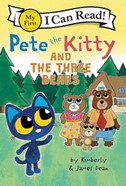 Pete the Kitty and the Three Bears (Pete the Kitty #7). Kimberly Dean & James Dean. Illus. by James Dean. (2024). Harper. “Once upon a time . . .” Pete the Kitty saw the empty house of the three bears while walking in the woods. No one was at home. Kimberly and James Dean give the Goldilocks tale an update as Pete the Kitty enters, eats Baby Bear’s just right pizza, plays and breaks a string on his just right guitar, and takes a nap in his just right bed. When Papa, Mama, and Baby Bear return home, they see what Pete has done and discover him still in Baby Bear’s bed. Here is where the Deans’ plot takes a big twist from the classic tale as Pete feels bad about his behavior and says he is sorry. “Everyone makes mistakes.” says Mama Bear; “We forgive you, Pete,” says Papa Bear; “Let’s be friends,” says Baby Bear. (PreK-Gr 2)  Stink and Webster Go to Mars (Judy Moody and Friends #15). Megan McDonald. Illus. by Erwin Madrid. (2024). Candlewick. Stink is planning his first-ever sleepover with his best friend, Webster. Judy, of course, is ready to advise him on the sleepover rules: 1. Have a theme, 2. Have an activity, 3. Have snacks, and 4. Don’t sleep. Webster’s arrival in his outer-space pajamas sets the theme, a trip to Mars. The boys convert Stink’s race-car bed into a spaceship, Sleep Rover SW1 (S for Stink, W for Webster, and 1 for their first sleepover). “Blastoff time!” The text, peppered with aerospace terminology, describes their activities including a spacewalk and an encounter with a Martian; the colorful digital illustrations show that their adventurous journey to the red planet actually takes place in Stink’s bedroom. Ignoring Judy’s “You cannot sleep” rule, the two tired Mars-o-nauts fall asleep after planning a sleepover trip to Venus for the next weekend. (PreK-Gr 2) 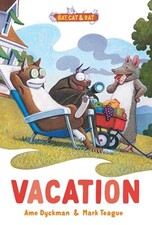 Vacation: Three-and-a-Half Stories (Bat, Cat & Rat #2). Ame Dyckman. Illus. by Mark Teague. (2024). Beach Lane. The trio of unlikely friends who moved in together in The Cozy Home (2024) is now ready for a vacation. In story #1 “Working,” they do odd jobs to refill their Vacation Jar—but not without some mischief. In story #2 “Choosing,” they must decide on a destination. Bat suggests outer space, Cat suggests the spa, and Rat suggests the buffet. When the time comes to choose on the count of three, “OUTER SPACE!” says Bat and “THE SPA!” says Cat. “EEK! says Rat. In story #2-and-a-half “Bickering,” Cat and Bat continue their squabble, and Rat leaves the house pulling a wagon with the Vacation Jar in it. In Story #3 “Vacationing,” Rat returns and interrupts Bat and Cat’s bickering and shouts, “EXCUSE ME! We don’t need a destination!” He has a telescope for Bat’s outer space choice, a lounge chair and cucumber slices for Cat’s spa choice, and a variety of snacks for his own buffet choice. “Their cozy home had everything they needed for THE BEST vacation!” (PreK-Gr 2) Carolyn Angus is former Director of the George G. Stone Center for Children’s Books, Claremont Graduate University, in Claremont, California.
|
AuthorsThese reviews are submitted by members of the International Literacy Association's Children's Literature and Reading Special Interest Group (CL/R SIG). Archives
May 2024
Categories
|

 RSS Feed
RSS Feed